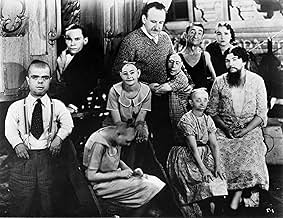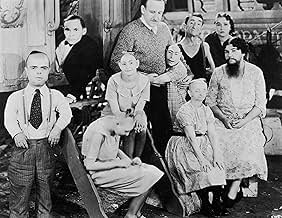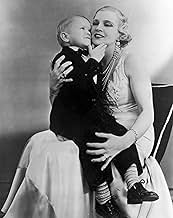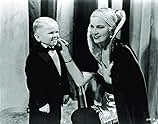IMDb रेटिंग
7.8/10
53 हज़ार
आपकी रेटिंग
अपनी भाषा में प्लॉट जोड़ेंA circus' beautiful trapeze artist Cleopatra agrees to marry Hans the leader of side-show performers, but Hans' deformed friends discover that she is only marrying him for his inheritance. S... सभी पढ़ेंA circus' beautiful trapeze artist Cleopatra agrees to marry Hans the leader of side-show performers, but Hans' deformed friends discover that she is only marrying him for his inheritance. So they seek revenge.A circus' beautiful trapeze artist Cleopatra agrees to marry Hans the leader of side-show performers, but Hans' deformed friends discover that she is only marrying him for his inheritance. So they seek revenge.
- पुरस्कार
- 2 जीत और कुल 1 नामांकन
Roscoe Ates
- Roscoe
- (as Rosco Ates)
Prince Randian
- The Living Torso
- (as Rardion)
फ़ीचर्ड समीक्षाएं
Banned in most countries for over three decades, this is one of the most bizarre and fascinating films Hollywood ever produced. Basically a soap-opera set in a side-show, it is a look into the lives of a group of sideshow performers in a traveling circus.
In the beginning of the film, we meet Cleopatra (Baclanova), a beautiful but avaricious trapeze artist who seduces and marries midget circus owner Hans (Earles) to get at his money. At the wedding reception, the close-knit society of freaks welcomes her into the family as "one of us, one of us." Cleopatra is disgusted however by this very thought and tells them she will never be grotesque, while her secret lover, Hercules the strongman, howls with laughter. She humiliates her smitten husband by openly kissing Hercules. After they find out they tried to poison Hans, the group comes up with an idea to take revenge at the beautiful trapeze artist and her strongman lover.
Tod Browning (DRACULA, THE UNHOLY THREE) put his career on the line with the making of this film. MGM, trying to compete with Universal, and cash in on the new appetite for horror films in the early thirties, never knew what hit them with this film. It caused quite a stir and such an amount of negative publicity they decided to virtually disown it and until the '60s it remained practically unseen. The fact that infamous bad film maker Dwain Esper (REEFER MADNESS, MANIAC, see my earlier review), showed the film in road shows and burlesque houses, only enhanced the film's notorious cult reputation.
Even today many scour away from seeing this film because of its supposed voyeurism. It might be seen as a very disturbing and ugly film, but at the same time a beautiful and ultimately a moving account of the shortcomings and prejudice of mankind. Most people didn't get it and many thought of it as a new low in Hollywood depravity and were horrified with the film. In truth it's a very warm and humane look at how physically deformed people manage on their own, and a fascinating insight in the world of side-show performers, a milieu Browning (a former "snake man" in the circus himself) was very familiar with. Not an outstanding film in terms of cinematic qualities, but because of the completely unique subject matter and the almost documentary like approach to the phenomenon of the side show, whilst using actual freaks, a term that didn't have the same connotation as today.
In 1994 the film was selected for the National Film Registry's archive of cinematic treasures. Rightfully so, not only because it's a unique piece of cinema but historically one the very few cinematic accounts left on attitudes towards disabled persons. Even today, the reluctance by most people to even admit this film's very existence, only exemplifies how many misunderstandings about people that are not "normal", still exist.
The recent DVD-release comes with the excellent documentary "Freaks: Sideshow Cinema."
Camera Obscura --- 9/10
In the beginning of the film, we meet Cleopatra (Baclanova), a beautiful but avaricious trapeze artist who seduces and marries midget circus owner Hans (Earles) to get at his money. At the wedding reception, the close-knit society of freaks welcomes her into the family as "one of us, one of us." Cleopatra is disgusted however by this very thought and tells them she will never be grotesque, while her secret lover, Hercules the strongman, howls with laughter. She humiliates her smitten husband by openly kissing Hercules. After they find out they tried to poison Hans, the group comes up with an idea to take revenge at the beautiful trapeze artist and her strongman lover.
Tod Browning (DRACULA, THE UNHOLY THREE) put his career on the line with the making of this film. MGM, trying to compete with Universal, and cash in on the new appetite for horror films in the early thirties, never knew what hit them with this film. It caused quite a stir and such an amount of negative publicity they decided to virtually disown it and until the '60s it remained practically unseen. The fact that infamous bad film maker Dwain Esper (REEFER MADNESS, MANIAC, see my earlier review), showed the film in road shows and burlesque houses, only enhanced the film's notorious cult reputation.
Even today many scour away from seeing this film because of its supposed voyeurism. It might be seen as a very disturbing and ugly film, but at the same time a beautiful and ultimately a moving account of the shortcomings and prejudice of mankind. Most people didn't get it and many thought of it as a new low in Hollywood depravity and were horrified with the film. In truth it's a very warm and humane look at how physically deformed people manage on their own, and a fascinating insight in the world of side-show performers, a milieu Browning (a former "snake man" in the circus himself) was very familiar with. Not an outstanding film in terms of cinematic qualities, but because of the completely unique subject matter and the almost documentary like approach to the phenomenon of the side show, whilst using actual freaks, a term that didn't have the same connotation as today.
In 1994 the film was selected for the National Film Registry's archive of cinematic treasures. Rightfully so, not only because it's a unique piece of cinema but historically one the very few cinematic accounts left on attitudes towards disabled persons. Even today, the reluctance by most people to even admit this film's very existence, only exemplifies how many misunderstandings about people that are not "normal", still exist.
The recent DVD-release comes with the excellent documentary "Freaks: Sideshow Cinema."
Camera Obscura --- 9/10
It's interesting to me that this film is viewed as offensive. People say that these people are being made fun of and exploited. I wouldn't like to comment on how they were treat on set or anything but I will say that they all see to enjoying them selfs for the most part and as for being made fun of, I think the total opposite is happening.
This movie came out in 1932 so before I watched it I also was nervous that these people would be used to make others laugh at their expense but it was the furthest thing from the truth. This film hands its subject matter with such care and deft that I was astounded that it came out in 1932.
It can be like looking at window into the past as sometimes it almost plays like a documentary due to the fact that most of these actors were actually circus performers. There are so many scenes where the performers are just relaxing and chatting to each other. It shows people they are just like us, it doesn't mater if they look different. It shows them doing mundane things like hanging washing, struggling with problems like infidelity. It shows ignorant people that they are human just like you.
I think the title "Freaks" is interesting. I think there is two ways to look at it. The first way is the obvious and offensive way demeaning the performers but I think by the end of the film the only freaks in this movie are the people who look normal. The movie shows this makeshift family coming together for each other, the only people who are outcasts are the able bodied "normal people". I think that is one way to interpret it any way or maybe I am reading into it.
That is the interesting thing about this movie. You can read a lot into it and it is never clear what the director was really trying to say as another interesting part is all of the performers are shown to be good people, kind people for the most part friendly and loving. Once again the only truly evil people in this movie are the people who are able bodied people. The reason I lean to the side of the director was showing these people are simply just people is it is framed as shocking and wrong when bad things happen to the performers and I don't think it is ever played for laughs.
It also really bothers me that this movie is labelled a horror movie. It is a drama. There isn't really any horror elements to be found.
One more thing I just want to point out is that I am astounded how much Ryan Murphy took from this movie for season 4 of American Horror Story. Like I think his only reference point for "freak shows" was this movie. Just a stray observation.
So I would say definitely watch this movie. It is only short as it was cut down due to the fact people believed it was too outrageous and offensive. It has a lot of heart and is really head of it's time.
This movie came out in 1932 so before I watched it I also was nervous that these people would be used to make others laugh at their expense but it was the furthest thing from the truth. This film hands its subject matter with such care and deft that I was astounded that it came out in 1932.
It can be like looking at window into the past as sometimes it almost plays like a documentary due to the fact that most of these actors were actually circus performers. There are so many scenes where the performers are just relaxing and chatting to each other. It shows people they are just like us, it doesn't mater if they look different. It shows them doing mundane things like hanging washing, struggling with problems like infidelity. It shows ignorant people that they are human just like you.
I think the title "Freaks" is interesting. I think there is two ways to look at it. The first way is the obvious and offensive way demeaning the performers but I think by the end of the film the only freaks in this movie are the people who look normal. The movie shows this makeshift family coming together for each other, the only people who are outcasts are the able bodied "normal people". I think that is one way to interpret it any way or maybe I am reading into it.
That is the interesting thing about this movie. You can read a lot into it and it is never clear what the director was really trying to say as another interesting part is all of the performers are shown to be good people, kind people for the most part friendly and loving. Once again the only truly evil people in this movie are the people who are able bodied people. The reason I lean to the side of the director was showing these people are simply just people is it is framed as shocking and wrong when bad things happen to the performers and I don't think it is ever played for laughs.
It also really bothers me that this movie is labelled a horror movie. It is a drama. There isn't really any horror elements to be found.
One more thing I just want to point out is that I am astounded how much Ryan Murphy took from this movie for season 4 of American Horror Story. Like I think his only reference point for "freak shows" was this movie. Just a stray observation.
So I would say definitely watch this movie. It is only short as it was cut down due to the fact people believed it was too outrageous and offensive. It has a lot of heart and is really head of it's time.
Don't let people convince you that "Freaks" is a horror movie, because it isn't. It's actually a quite sad and sympathetic look at the way abnormalities were treated in the early part of the 20th century, and has direct parallels to the obsession with physical perfection causing eating disorders today. Tod Browning of course asks us to consider who are the bigger freaks: those with deformed bodies or those with deformed souls? The two "normal" people who are out to cheat and steal are monstrous, whereas the freaks are quite likable and charming. The ending is disturbing to be sure, but it's hard to condemn the freaks for acts that seem largely justified.
Is it a coincidence that in several shots showing Cleopatra reclining on a sofa, she appears to be deformed herself (in one shot it looks as if she has no legs). Has anybody else noticed this? "Freaks" was obviously way ahead of its time. There's a very interesting documentary on the DVD about its reception in 1932; it bombed and pretty much ruined Browning's career. Thank God that the general public is not allowed to be the final arbiter of a film's value. Think how many priceless films we would have lost by now if that were the case.
Grade: A
Is it a coincidence that in several shots showing Cleopatra reclining on a sofa, she appears to be deformed herself (in one shot it looks as if she has no legs). Has anybody else noticed this? "Freaks" was obviously way ahead of its time. There's a very interesting documentary on the DVD about its reception in 1932; it bombed and pretty much ruined Browning's career. Thank God that the general public is not allowed to be the final arbiter of a film's value. Think how many priceless films we would have lost by now if that were the case.
Grade: A
D-U-M-B! Everyone's accusin' me!
I've been listening to The Ramones' music off and on for almost 30 years now, and despite reading and viewing tons of stuff about the band and its origins, I'd never run across how they came up with the whole "pinhead" theme.
Well, I've finally seen FREAKS, often listed as one of the great cult flicks of all time. And wouldn't you know it, the "pinheads", including "Schlitze", the inspiration for The Ramones' mascot who always came out to join the band during their live shows at the end of the Pinhead song, were in FREAKS.
The Ramones also slightly modified the "freak chant" from the wedding scene, changing "Gooble-Gobble" to "Gabba-Gabba". I guess Jeffrey Hyman (Joey Ramone) must have viewed himself as somewhat "freakish" (he did have an incredible look), and really related to the group of circus curiosities assembled for this film.
After being shelved for about three decades, FREAKS started playing again at art-house theaters in the mid-60's, and that's where Joey had to have come across it.
As far as my film review, this movie needs to be viewed. Look past the stilted acting, and soak up the message. It will stay with you for a long, long time.
I've been listening to The Ramones' music off and on for almost 30 years now, and despite reading and viewing tons of stuff about the band and its origins, I'd never run across how they came up with the whole "pinhead" theme.
Well, I've finally seen FREAKS, often listed as one of the great cult flicks of all time. And wouldn't you know it, the "pinheads", including "Schlitze", the inspiration for The Ramones' mascot who always came out to join the band during their live shows at the end of the Pinhead song, were in FREAKS.
The Ramones also slightly modified the "freak chant" from the wedding scene, changing "Gooble-Gobble" to "Gabba-Gabba". I guess Jeffrey Hyman (Joey Ramone) must have viewed himself as somewhat "freakish" (he did have an incredible look), and really related to the group of circus curiosities assembled for this film.
After being shelved for about three decades, FREAKS started playing again at art-house theaters in the mid-60's, and that's where Joey had to have come across it.
As far as my film review, this movie needs to be viewed. Look past the stilted acting, and soak up the message. It will stay with you for a long, long time.
The subject of human disability is still a taboo subject in Cinema, even over 70 years since this film's release.
It's difficult to imagine what impact this film would have had in the 1930's, but as it still has the ability to shock ( through the images of bodily deformity ) I can understand why many shunned and disowned this work, and why it totally ruined Todd Browning's film career.
The basic premise - that beauty is more than skin deep - can appear to be wielded with a sledgehammer, but perhaps the contemporary audience needed to be hit harder in order to make them understand the point.
The film is short ( due to enforced cuts ), and at times can move rather slowly and can appear rather 'stagey' which is a trait of many films from the 20's / 30's.
But don't let that put you off. The plot is simple, but it's the telling of the story rather than the story itself that is important. And you really do need to remind yourself that these are real people - not actors - and this was the live they led.
I rate it 9 outa 10 because they really don't make them like this any more.
It's difficult to imagine what impact this film would have had in the 1930's, but as it still has the ability to shock ( through the images of bodily deformity ) I can understand why many shunned and disowned this work, and why it totally ruined Todd Browning's film career.
The basic premise - that beauty is more than skin deep - can appear to be wielded with a sledgehammer, but perhaps the contemporary audience needed to be hit harder in order to make them understand the point.
The film is short ( due to enforced cuts ), and at times can move rather slowly and can appear rather 'stagey' which is a trait of many films from the 20's / 30's.
But don't let that put you off. The plot is simple, but it's the telling of the story rather than the story itself that is important. And you really do need to remind yourself that these are real people - not actors - and this was the live they led.
I rate it 9 outa 10 because they really don't make them like this any more.
क्या आपको पता है
- ट्रिवियाThe on-screen romance between Hans and Frieda was very subdued because the roles were being played by real life brother and sister Harry Earles and Daisy Earles.
- गूफ़At 43:40 when Cleo tosses the wine at Angeleno, she is standing in front of him, but the wine she throws comes from the far right side of the frame.
- भाव
Freaks: We accept you, one of us! Gooble Gobble!
- इसके अलावा अन्य वर्जनReissue prints included a two-and-a-half minute written prologue about historical interpretations and contemporary studies of "misshapen misfits." These same prints remove the MGM Lion (the studio having disowned the film for many years).
- कनेक्शनEdited into Histoire(s) du cinéma: Le contrôle de l'univers (1999)
टॉप पसंद
रेटिंग देने के लिए साइन-इन करें और वैयक्तिकृत सुझावों के लिए वॉचलिस्ट करें
विवरण
- रिलीज़ की तारीख़
- कंट्री ऑफ़ ओरिजिन
- भाषाएं
- इस रूप में भी जाना जाता है
- Fenómenos
- फ़िल्माने की जगहें
- उत्पादन कंपनी
- IMDbPro पर और कंपनी क्रेडिट देखें
बॉक्स ऑफ़िस
- बजट
- $3,10,607(अनुमानित)
- दुनिया भर में सकल
- $4,693
- चलने की अवधि
- 1 घं 4 मि(64 min)
- रंग
- पक्ष अनुपात
- 1.37 : 1
इस पेज में योगदान दें
किसी बदलाव का सुझाव दें या अनुपलब्ध कॉन्टेंट जोड़ें







































